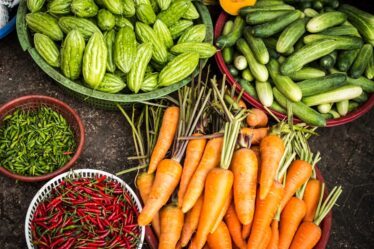
Drying basil leaves is a simple and effective way to preserve this aromatic herb for future use. Basil leaves are commonly used in various cuisines around the world, and drying them allows you to enjoy their flavor and aroma even when they are out of season. Whether you have an abundance of fresh basil from your garden or want to stock up on this versatile herb, drying basil leaves is a great option.
Drying basil leaves not only extends their shelf life but also helps retain their flavor and aroma. Fresh basil leaves have a short shelf life and can quickly wilt or spoil if not used promptly. By drying the leaves, you can ensure that they stay fresh and usable for an extended period. Additionally, dried basil leaves can be easily incorporated into various dishes, making them a convenient option for cooking.
Key Takeaways
- Drying basil leaves is a great way to preserve their flavor and aroma for later use.
- Dried basil leaves have a longer shelf life and can be used in a variety of dishes.
- Choose fresh, healthy basil leaves for drying to ensure the best flavor and quality.
- Properly preparing basil leaves for drying is important to ensure even drying and prevent mold growth.
- There are three main methods for drying basil leaves: air-drying, oven-drying, and dehydrator-drying.
The Benefits of Drying Basil Leaves
One of the main benefits of drying basil leaves is the longer shelf life it provides. Fresh basil leaves can wilt and spoil within a few days, but dried basil leaves can last for months if stored properly. This allows you to have access to the herb year-round, even when it’s not in season.
Another advantage of drying basil leaves is that it helps retain their flavor and aroma. Basil leaves contain essential oils that give them their distinct taste and smell. When dried properly, these oils are preserved, ensuring that the dried basil retains its original flavor profile. This makes dried basil leaves a great substitute for fresh basil in recipes.
Dried basil leaves also offer convenience in cooking. Unlike fresh basil, which needs to be used quickly before it spoils, dried basil can be stored and used whenever needed. This makes it easy to add a burst of flavor to your dishes without worrying about the freshness of the herb.
Choosing the Right Basil Leaves for Drying
Not all varieties of basil are suitable for drying. Some varieties have a stronger flavor and aroma, making them ideal for drying. Sweet basil, Genovese basil, and Thai basil are popular choices for drying due to their robust flavors. These varieties have a higher concentration of essential oils, which enhances the taste and aroma of the dried leaves.
When it comes to harvesting basil leaves for drying, it’s important to choose the optimal time. Basil leaves should be harvested before the plant starts to flower. At this stage, the leaves have the highest concentration of essential oils, ensuring a more flavorful dried herb. Harvesting in the morning, after the dew has dried but before the sun is too hot, is recommended for the best results.
Preparing Basil Leaves for Drying
| Step | Metric |
|---|---|
| Harvesting | Number of basil plants harvested |
| Washing | Amount of water used for washing |
| Drying | Time taken for drying |
| Storing | Duration of storage |
Before drying basil leaves, it’s important to properly prepare them. Start by washing the leaves thoroughly to remove any dirt or debris. Gently pat them dry with a clean towel or use a salad spinner to remove excess moisture.
Next, remove the stems from the basil leaves. The stems can be tough and woody, so it’s best to discard them before drying. Additionally, remove any damaged or discolored leaves as they may affect the quality of the dried basil.
Methods for Drying Basil Leaves
There are several methods you can use to dry basil leaves: air-drying, oven-drying, and dehydrator-drying. Each method has its own advantages and can yield excellent results.
Air-drying is the most traditional method of drying herbs and requires minimal equipment. It involves hanging the basil leaves in a well-ventilated area until they are completely dry. This method is simple and allows the herbs to dry naturally, preserving their flavor and aroma.
Oven-drying is a quicker method that uses low heat to dry the basil leaves. It requires an oven set at a low temperature and allows for faster drying compared to air-drying. However, it’s important to monitor the leaves closely to prevent them from burning or losing their flavor.
Dehydrator-drying is a popular method for drying herbs as it provides consistent and controlled drying conditions. A dehydrator uses low heat and airflow to remove moisture from the basil leaves. This method is efficient and ensures that the herbs are dried evenly.
Air-Drying Basil Leaves: Step-by-Step Guide

To air-dry basil leaves, start by preparing the leaves for drying. Wash them thoroughly and pat them dry with a clean towel. Remove the stems and any damaged leaves.
Next, choose a location for air-drying. It should be well-ventilated and away from direct sunlight. You can hang the basil leaves in small bunches using twine or place them on a clean, dry surface.
Allow the basil leaves to air-dry for about 1-2 weeks, or until they are completely dry and brittle. Check the leaves regularly to ensure they are drying evenly and not developing any mold or mildew.
Oven-Drying Basil Leaves: Step-by-Step Guide
To oven-dry basil leaves, start by preparing the leaves as mentioned earlier. Wash them, remove the stems, and pat them dry.
Preheat your oven to the lowest temperature setting, usually around 170°F (77°C). Line a baking sheet with parchment paper or a silicone baking mat.
Spread the basil leaves in a single layer on the baking sheet, making sure they are not overlapping. Place the baking sheet in the preheated oven and leave the door slightly ajar to allow moisture to escape.
Check the basil leaves regularly to ensure they are not burning or losing their flavor. The drying time can vary depending on the thickness of the leaves and your oven’s temperature. It usually takes around 1-2 hours for the basil leaves to dry completely.
Dehydrator-Drying Basil Leaves: Step-by-Step Guide
To dehydrator-dry basil leaves, prepare them as mentioned earlier. Wash them, remove the stems, and pat them dry.
Set your dehydrator to the lowest temperature setting, usually around 95°F (35°C). Arrange the basil leaves in a single layer on the dehydrator trays, making sure they are not overlapping.
Place the trays in the dehydrator and allow the basil leaves to dry for about 4-6 hours. Check the leaves regularly to ensure they are drying evenly and not becoming too brittle.
Storing Dried Basil Leaves
Once your basil leaves are completely dry, it’s important to store them properly to maintain their quality. Transfer the dried leaves to airtight containers, such as glass jars or resealable bags. Make sure to label the containers with the date of drying.
Store the dried basil leaves in a cool, dark place away from direct sunlight and moisture. The ideal storage conditions are a pantry or cupboard with a consistent temperature and low humidity.
Dried basil leaves can last for up to a year if stored properly. However, it’s best to use them within six months for optimal flavor and aroma.
Tips for Using Dried Basil Leaves in Cooking
To rehydrate dried basil leaves, simply soak them in warm water for a few minutes before using. This will help soften the leaves and release their flavor. Alternatively, you can add dried basil directly to soups, stews, or sauces during cooking.
Dried basil leaves can be used in a variety of dishes, including pasta sauces, marinades, salad dressings, and even baked goods. They add a burst of flavor and aroma to any recipe.
If a recipe calls for fresh basil but you only have dried basil on hand, you can substitute one teaspoon of dried basil for every tablespoon of fresh basil. Keep in mind that dried herbs are more concentrated, so adjust the amount accordingly.
Drying basil leaves is a simple and effective way to preserve this versatile herb for future use. It offers several benefits, including a longer shelf life, retention of flavor and aroma, and convenience in cooking. By choosing the right basil leaves, properly preparing them, and using the appropriate drying method, you can enjoy the taste and aroma of basil year-round. Whether you air-dry, oven-dry, or dehydrator-dry your basil leaves, make sure to store them properly to maintain their quality. With dried basil leaves on hand, you can easily add a burst of flavor to your favorite dishes. So why not give drying basil leaves a try and elevate your culinary creations?
If you’re a fan of basil leaves, you’ll definitely want to check out this informative article on how to dry basil leaves for long-term use. It provides step-by-step instructions on the best methods for drying basil leaves and offers tips on how to store them properly. Whether you’re an avid cook or simply enjoy adding a touch of freshness to your dishes, dried basil leaves can be a convenient and flavorful addition to your pantry. To learn more about preserving the vibrant taste of basil, click here: https://flavorfulsips.com/how-to-dry-basil-leaves-for-long-term-use/.



